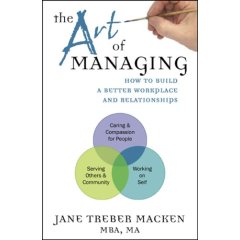I've just read Jane Treber Macken's, "The Art of Managing: How to Build a Better Workplace and Relationships," and I quite enjoyed it. The beginning of the book felt a bit academic, sharing a lot about the history of management theory, and an overview of various management models and techniques used in the last 150 or so years. But don't let the clinical introduction turn you away - once the book gets going, the author adds a lot of interesting tools and engaging examples that make this a very good read.
 The book is short - only about 100 pages - but it covers a lot of ground in a very effective fashion. Macken does a wonderful job of weaving in material from noted management experts, along with her own personal stories of life and management. She also presents some useful tools and mental models to help you become a more effective manager.
The book is short - only about 100 pages - but it covers a lot of ground in a very effective fashion. Macken does a wonderful job of weaving in material from noted management experts, along with her own personal stories of life and management. She also presents some useful tools and mental models to help you become a more effective manager.
Managing by sitcom
A lot of the fun in this book comes from the way Macken livens things up with things you don't always seen in management books. For example, one model I liked exploring describes office relationship styles in terms of characters from the "I Love Lucy" and "Leave It To Beaver" television shows. I'm a cross between "Ethel" and "Ward," trying to become more consistently "Ward."
I was a huge fan of these shows, so it was a fun exercise for me (and, even if you know nothing about those television shows, Macken describes how to use the model to apply it within your own context).
A plethora of tools
Other models and tools she discusses with her own spin include the Myers-Briggs Type Indicator model, group development and conflict resolution techniques, motivational techniques, and a model for situational leadership.
Finally, she rounds it out with a great set of tools to assess the effectiveness and alignment of an organization, and discusses methods to address any weaknesses or mis-alignment you may discover.
In summary, I liked this book because it gave me some new twists on some familiar management models, as well as teaching me some new tools and techniques I can apply to become a better manager. I believe it would be equally useful to new managers and seasoned veterans.
